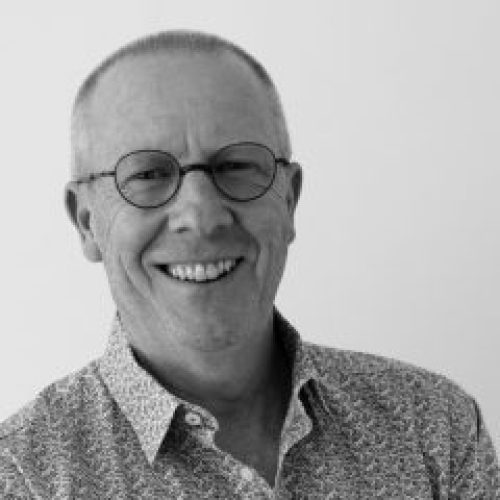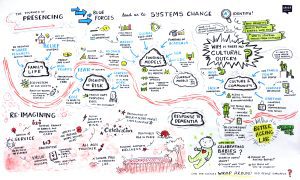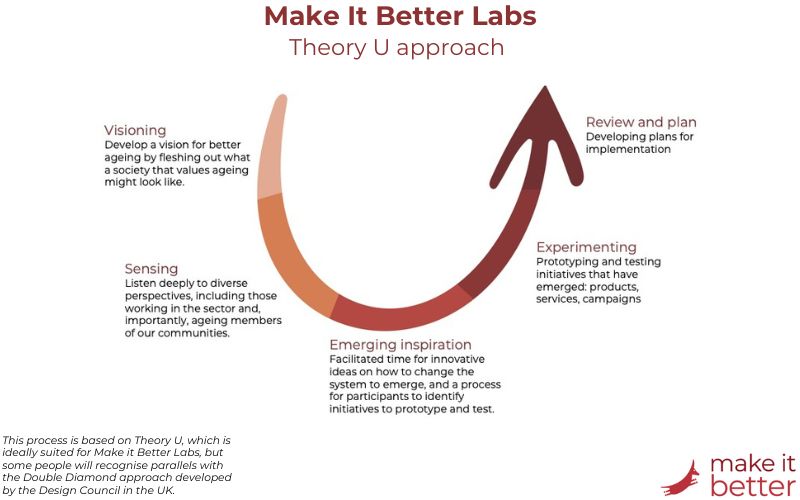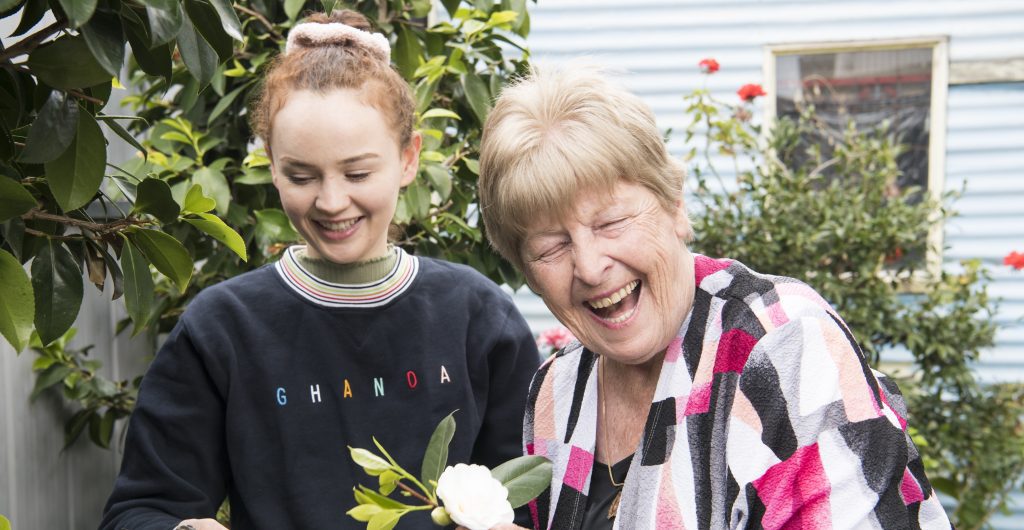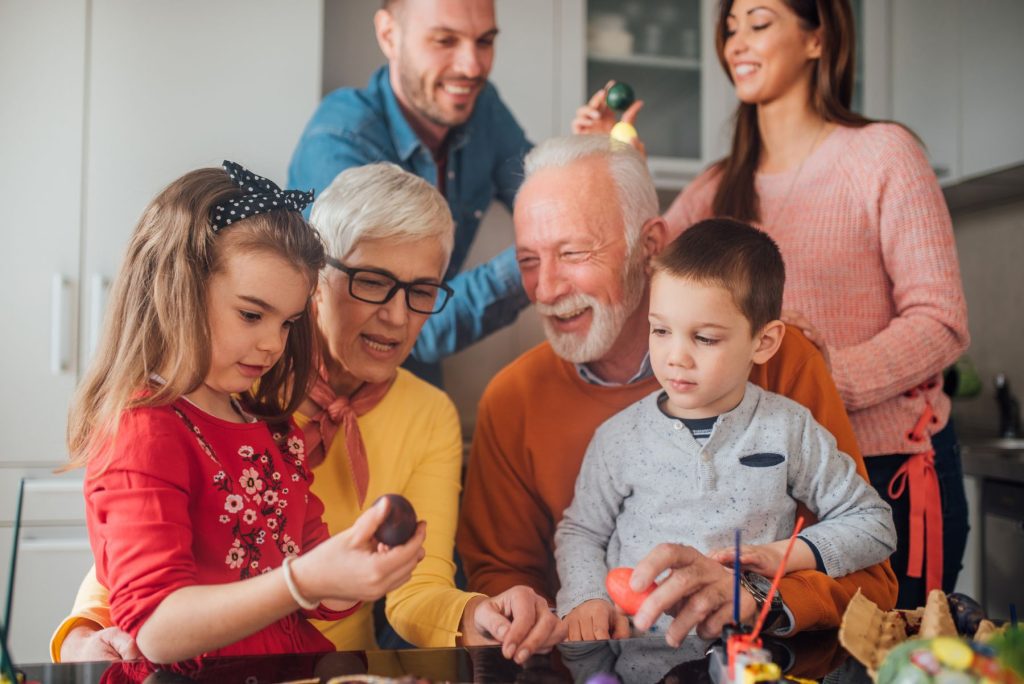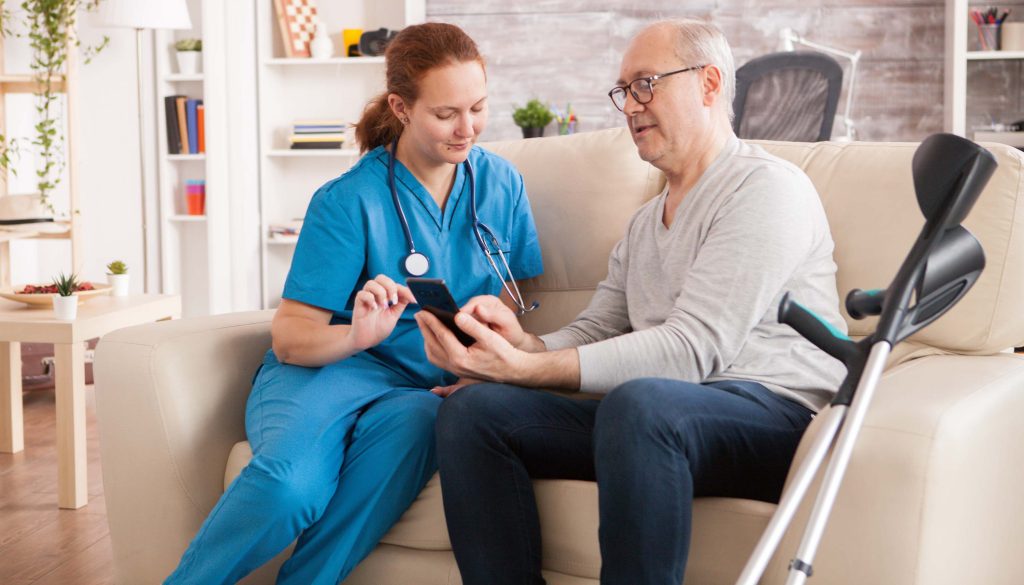Jump to: Col’s Advice | Recommended Tools
Why is ‘better ageing’ an important area for change making?
When the The Royal Commission into Aged Care Quality and Safety shone a light on the poor quality of care and life experienced by ageing Australians, Col knew that this was something that needed a forum and advocacy to redefine the future.
Make It Better met with Agnes, and together it was established that the time for community-driven efforts to re-imagine ageing in Australia had come. The goal was to tap into the insights of those with lived experience and design a system that supports the ageing journey Australians actually want.
So The Better Ageing Lab was developed in partnership with Agnes, and integrated into the Make It Better processes and framework.
Commencing in the first half of 2020, the Better Ageing Lab kicked off with a diverse cohort of 20 fellows. This included older people (still living at home); professionals working in the aged care sector; people with entrepreneurial skills interested in ‘Better Ageing’; people with a personal mission/passion within ‘Better Ageing’, and people with lived experience of a loved one ageing.
Is ageism prevalent in our culture and beliefs?
From the outset, the overwhelming and pervasive theme the group kept coming back to was ageism. And anecdotes of how prevalent and deep ageism is in our community continued to grow.
Col estimates the general feeling at the start of the process would have been along the lines of ‘well yeah, of course ageism is somewhere in there, and we’ll just unpack it along the way’. But as one begins to hear more and more stories, it starts to dawn on you just how significant the depth, and the severity, of ageism is. Which is what makes it so strong and ingrained in Australian culture.
For example, this could include talk of how challenging it is for older people in the workforce, or the way that people are treated in aged care facilities, and extended also to family attitudes.
Col shares that “our unconscious beliefs stem from the Western culture approach to ageing, where we’ve developed a system of ‘managing’ older people – and I use the word ‘managing’ intentionally – by separating them from family. As opposed to embracing them within a kind of extended family.”
Ageism was the recurring theme that everything kept coming back to.
[Image source: The Better Ageing Lab / Make It Better]
Why inner work and addressing biases is crucial
Looking back, there are a couple of things Col would tweak with The Better Ageing Lab process, which relate to the personal development of those who participated. This has had a cascading impact on how Make it Better thinks more broadly about the kind of changemakers they are drawn to support.
He says, “in many ways, we did design the Lab process to include doing the inner work. However, I think some of the most powerful moments and realisations were: people recognising that the inner journey we all have to go through is actually the main work. We previously knew the importance, I just don’t think we understood it was the most important.
I used to think that the inner development stuff was just a nice addendum. When companies or individuals had the appetite to go there, you would take it as a bonus, get some extra traction on the [outer world] work that you’re doing.
But I think we’ve got to a point in Make It Better of considering this in the criteria for whether we will get behind and support a changemaker or not. We’re searching for an appetite to do the work of walking that inner development journey. If that’s not there, then we probably won’t stick up our hand to support them.”
Col finds it hard to convey the depth of the cohort’s experience to someone outside of the group. But just imagine, here is a room of people all gathered together to make a difference toward better ageing, many of whom have dedicated their whole lives and careers to making progress on this change. And then these same people start listening and sharing. And they begin to realise, ‘actually, the hardest work is right here – within myself’.
For Col, this tough realisation illustrated the strength and the commitment of the cohort. He felt that “seeing the integrity that emerged in this group of people, who had chosen to journey together over the eighteen months, was really quite profound and meaningful”.
There were other collective feelings stemming from this as the group went on. Such as the work to define a project, get funding or start figuring out how to build a solution. This had started to seem like the easy part . The hardest work would be accepting how our own perspective and actions might be reflecting ageism. And recognising our own hypocrisy and the systemic issues we’re all participating in as part of life.
So the journey of the group went really deep into some form of recognising their own internalised ageism. And the bigger picture of how to move forward began to develop.
It didn’t matter whether the individual was older or younger themselves. And for the fellows working in the sector, they were starting to see perhaps there is a bias that is systemic. Or acknowledging a particular bias that they have been holding, while realising it has also impacted a real life situation. All this, of course, can be very confronting.
Facilitating trust, vulnerability and connection for ‘presencing moments’
Col doesn’t want to speak for other people, as different group members felt the impacts and realisations of ageism in different ways.
And he believes “it would be disingenuous to say that the inner journey was always all about ageism! It’s more about a recognition that there’s work we’ve all got to do internally, and keep on doing it. Especially in order to be effective in the work that we are purporting to do”.
While changemakers may be motivated and passionate about making a change, those qualities need to extend into the inner journey.
So how does a facilitator create a safe and conducive environment to bring about these deep kinds of realisations?
Col is a big advocate for ‘presencing moments’.
He describes these as “when the group collectively has a deep aha moment. It’s more than just a rational sense of ‘we should do this’ or ‘we can do that’. But there’s this kind of welling up from within the group collectively, of what they think might be happening or needs to happen”.
One of the key tools used by the facilitators in the Make It Better Lab process is Theory U (originally developed by Otto Scharmer and the Presencing Institute).
The essential idea of Theory U is that you walk on a slow journey. This is designed to achieve a number of things, but an important reason is to prevent people from jumping to solutions early.
[Image source: Make It Better]
Achieving ‘presencing moments’ involves lots of listening early on. This helps to create deep trust and connection in the group. And this nurtures the environment for lots of personal sharing and storytelling to happen.
How to create a culturally widespread movement
A big focus for the first phase of the Lab was: how do you generate momentum and mindset changes – at a population level? Essentially, how can a changemaker create a cultural movement?
In a perfect example of why the recipe for Make It Better Labs is so effective, a person connected with the Make It Better community was from a global company that specialises in movement making! He was able to come and speak to the group for one workshop about how movements are seeded and generated.
Col realised this knowledge would be so important for the cohort to understand. Ageism may have been the core theme that kept emerging among the discussions in the group. But that had begun to evolve into a new understanding; until our culture and the fellows themselves tackled ageism as a mindset, the true vision of ‘better ageing’ would not be possible. Otherwise, none of the initiatives people work on were going to get any real traction in the broader community.
So the speaker focused on sharing how a movement can be created at a mass level. He gave a TED-style talk and workshop for one day towards the beginning of the Lab’s timeline. This helped to set the tone and direction as the majority of the series unfolded.
Which Better Ageing ideas are worth Championing?
As the Lab progressed, change making ideas began to formulate. However, it was really important that the ones ‘worth doing’ also had a committed ‘champion’ to be responsible for them.
If an idea didn’t have a champion, it wasn’t supported to go ahead any further.
Col explains that “the Lab model means that if a particular idea, initiative or project doesn’t have a driver – someone that’s prepared to stick up their hand and say, ‘I will lose sleep over this, I will make it happen’ – then we say ‘nice idea, but if no one’s prepared to drive it, it falls off the list OK?’”.
This was at times a challenging position to take. An example that illustrates this was when one fellow who was really passionate about supporting a particular idea. But in reality, for their stage of life and energy, they couldn’t make the commitment to be a champion.
The 20+ fellows the Lab had in the room came from a diverse mix of experience, competence, expertise, mindsets and ambitions. And it takes a particular kind of person to successfully champion an idea through to its real potential. Someone with entrepreneurial thinking and skills, as it takes a lot of drive and initiative to seed an idea. It needs people who are able to stick up their hand and say ‘with everything else going on in life, yep, I’m gonna own this and drive this’.
During the lab, the process for selecting appropriate champions for the best ideas played out. And then the rest of the fellows stepped in behind to support one of the ideas and its respective champion. But make no mistake, every one of the fellows made a valuable contribution to the process.
Mentoring and support for entrepreneurs and changemakers
When developing the concept for The Better Ageing Lab, one of the key outcomes that Col and Chris conceived as they went into it was that “we would take people through this journey. And then coming out the other side would be some initiatives, projects, ideas. That would be the real work. So that The Better Ageing Lab was a platform (a garden bed if you like) to seed some ideas”.
The Lab was ultimately designed for what could emerge out the other side. Projects that would require significant funding and had potential as impact projects of a broader scope. And in response to this, it was recognised that the Lab needed to take people on a journey.
One of the big challenges that The Better Ageing Lab found as it neared the end of its process, was the varying capacity of the championed ideas. And this largely correlated to the entrepreneurial capacity of the people that are driving them.
If we are looking at creating a movement on a population scale, there needs to be big ideas coming to fruition. Significant initiatives making a marked and sustainable impact.
And ‘presencing moments’ are such a key part of this. It takes months of working together to develop the kind of trust between the participants that’s needed. Col believes that “collective ‘aha’ moments have this kind of magic, which leads into ideas, and then initiatives flow out of that”.
Keeping up Better Ageing beyond the Lab
Near the end of the eighteen month Lab process, Col shares “the collective opinion in the group kept coming back to ‘we don’t want the Lab to stop, because this has been so significant for us’. This was ultimately coming from a place of ‘we can’t imagine continuing to do our work without a forum like this, where we can come and share our struggles’.”
Col explains “so we came up with a loose structure as a group, without any particular name at the time. But the image that we used was essentially a river, made up of two main streams. The biggest stream was for gathering practitioners and people that are working for Better Ageing. To get together as a group is what we called the river. And then coming off the river are channels, which represent the championed projects.”
This model of the river was then categorised as a project itself. Which, of course, meant it needed a champion. The next step was to find out ‘is there anyone here who envisions the convening of a cohort of change makers working towards Better Aging?’. And if so, ‘is there anyone here that is willing to take that on as an ongoing project?’.
At present, the first stream is a championed project. Then on the back of that, there will be a secondary project for a community to gather. Or perhaps even a couple – they may come together or may keep separate. And they will continue to bring together people that are working in ageing.
At the moment, one of the streams is particularly around intergenerational models of care. And the other has a broader scope. Only one has a name at this point, and so far they’re mostly moving in parallel. While neither are officially under The Better Ageing Lab, they are intended to carry on the same mission and purpose.
What’s next for Col and The Better Ageing Lab?
The Better Ageing Lab was designed to be a one-off eighteen month series. While there are no plans for that to change, Make it Better will continue to support initiatives that have emerged from the process.
An interim ‘container’ was developed to continue to bring people back together, which they’ve called The Better Aging Table. A group has formed to design and run it. Col shares “and really, at this point, it’s just a minimum viable product. Sort of a middle, minimalist approach to saying, ‘how do we keep people from The Better Aging Lab connected going forward, until something more substantial emerges?’”
Col’s advice for entrepreneurs Re-imagining Ageing
- There’s no question that since the Lab, Col’s awareness of the prevalence of ageism has certainly increased. This is how he translates that into actionable advice:
- Do the inner work to address your own biases first.
- Do it in a community with kindred spirits. And no, he doesn’t just mean within your business.
- Join up momentums: Don’t ‘collaborate’ with other people on a shared project; instead, combine the momentum of your individual projects that are making progress in parallel.
- Prioritise your own and your team’s commitments based on competencies for achieving the end-goal initiatives.
Tools and Resources
The Make It Better toolkit:
- High touch, low tech.
- Work hard to cultivate environments where people build trust fairly quickly (as this best complements the design of the process).
- Facilitate conversations.
Col’s other recommended tools:
- Theory U [See also: Otto Scharmer and Presencing Institute]
- Inner Development Goals

